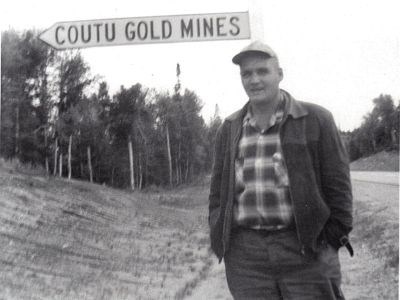In 1955, Wilfred H. Coutu staked out a handful of mining claims in Lake Superior Provincial Park with the dream of operating a gold mine.
Changes to provincial legislation meant he never got to fulfill that dream during his lifetime, but his sons are now looking to revive it in his memory.
An experienced trapper who grew up in Sault Ste. Marie, Wilfred was familiar with the Algoma region, having spent much of his youth in the bush, his son, Pete Coutu, said.
After spending time along the shores of Lake Superior and the Montreal River, and further north, Wilfred headed to Wawa where he found work in construction and, later, building sinter plant chimneys.
He eventually landed employment at the open-pit Helen Mine, Ontario’s first largescale iron mine.
But it was his familiarity with the Algoma bush that led him to the discovery of gold mineralization in Lake Superior Provincial Park, Coutu said.
Wilfred and some partners incorporated Coutu Gold Mines Ltd. with the intention of developing the 262-acre property.
“They originally staked about 30 claims, but they were only allowed to keep 10 of them because they had to have what they call 'proof of mineralization' on the property,” Coutu said. “A government geologist went in and looked and he couldn’t find any mineralization on about 20 of the claims—they only found mineralization on about 10 of them.”
Minimal exploration activity was conducted on the property, located in the heart of the park, before the Ontario government put limitations on exploration and prospecting within provincial parks.
“The company only ever had mining rights and mineral rights, but never had surface rights, and they had to apply for work permits all the time to do any work on the property itself,” Coutu said. “In 1970, there was a change of legislation in the Mining Act and the Parks Act, and (the government) absolutely stopped issuing work permits anymore. The company dissolved two years later.”
With that dissolution, the mining claims were returned to the Crown, and before Coutu and his family could make a case to get them back, Coutu Gold Mines Ltd. had to be reincorporated by the provincial government.
Coutu quickly gained the support of Sault Ste. Marie MPP David Orazietti, who sponsored legislation in the Standing Committee of Regulations and Private Bills to revive the company.

Sault Ste. Marie MPP David Orazietti is flanked by brothers Pete (left) and Pat Coutu, who have launched a bid to reincorporate Coutu Gold Mines Ltd., a gold-mining exploration company founded by their father, Wilfred H. Coutu in 1955.
“I am pleased to help support the reestablishment of a business in Northern Ontario that has the potential to contribute to the local economy,” Orazietti said after second reading of the bill was ordered May 16. “Ontario leads all Canadian jurisdictions in mineral exploration and it is important that we continue to encourage responsible investments that will further develop this sector and create jobs in Sault Ste. Marie and Algoma.”
The bill passed second and third reading on June 11 and received Royal Assent on June 19.
With the company back on track, Coutu believes there is a solid case for development on the property. An early company prospectus shows an estimated 65,000 tonnes of ore at an average of 0.5 ounce of gold per tonne, while another projects a shorter ore shoot with a steeply dipping fault at 55,000 tonnes grading one ounce of gold or better to the tonne, Coutu said.
“At a drilled or proven and estimated tonnage, there’s pretty close to 100,000 tons and running at least a half-ounce to an ounce a ton, so there’s a minable amount of ore right there,” said Coutu, a geologist who has worked at Magino Mine in Wawa.
“And there’s further room for development on that property besides.”
Even with Coutu Gold Mines revived, the family faces another hurdle before it can get to work.
The current Mining Act prohibits staking claims, prospecting or development in provincial parks, and Coutu would need to get a portion of the park’s status changed to allow industrial use.
Coutu is not deterred. He points to the Myra Falls Mine, operating within Strathcona-Westmin Provincial Park on Vancouver Island, B.C., as an example of a working mine within a provincial park, and believes a similar arrangement could be made in Ontario. With mining booming, he said now is an opportune time to consider opening up parkland to mineral exploration.
He’ll also have to source out investors.
The company has three million shares and so far has distributed 465,000 of those shares, but Coutu acknowledges it’s a small company and to make any money, he’ll have to keep operations as small as possible. If all goes as planned, he predicts it will be at least a year or two before the company is up and running.
“We’re not trying to be a speculative company—we want to develop it to mine ourselves,” Coutu said. “If we can get those claims back, I’m sure that there’s enough
gold there to start up a mine.”




